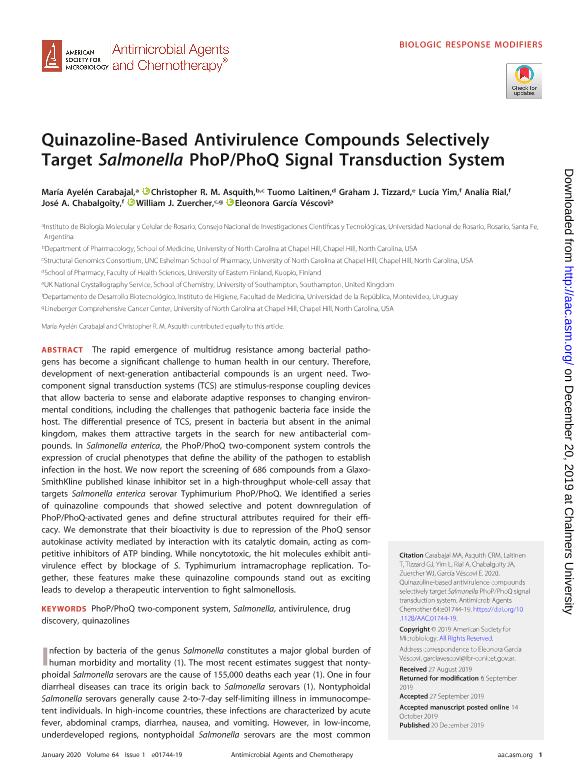Artículo
Quinazoline-Based Antivirulence Compounds Selectively Target Salmonella PhoP/PhoQ Signal Transduction System
Carabajal, María Ayelén ; Asquith, Christopher R. M.; Laitinen, Tuomo; Tizzard, Graham J.; Yim, Lucía; Rial, Analía; Chabalgoity, José A.; Zuercher, William J.; Garcia Vescovi, Eleonora
; Asquith, Christopher R. M.; Laitinen, Tuomo; Tizzard, Graham J.; Yim, Lucía; Rial, Analía; Chabalgoity, José A.; Zuercher, William J.; Garcia Vescovi, Eleonora
 ; Asquith, Christopher R. M.; Laitinen, Tuomo; Tizzard, Graham J.; Yim, Lucía; Rial, Analía; Chabalgoity, José A.; Zuercher, William J.; Garcia Vescovi, Eleonora
; Asquith, Christopher R. M.; Laitinen, Tuomo; Tizzard, Graham J.; Yim, Lucía; Rial, Analía; Chabalgoity, José A.; Zuercher, William J.; Garcia Vescovi, Eleonora
Fecha de publicación:
12/2019
Editorial:
American Society for Microbiology
Revista:
Antimicrobial Agents and Chemotherapy
ISSN:
0066-4804
Idioma:
Inglés
Tipo de recurso:
Artículo publicado
Clasificación temática:
Resumen
The rapid emergence of multidrug resistance among bacterial pathogens has become a significant challenge to human health in our century. Therefore, development of next-generation antibacterial compounds is an urgent need. Two-component signal transduction systems (TCS) are stimulus-response coupling devices that allow bacteria to sense and elaborate adaptive responses to changing environmental conditions, including the challenges that pathogenic bacteria face inside the host. The differential presence of TCS, present in bacteria but absent in the animal kingdom, makes them attractive targets in the search for new antibacterial compounds. In Salmonella enterica, the PhoP/PhoQ two-component system controls the expression of crucial phenotypes that define the ability of the pathogen to establish infection in the host. We now report the screening of 686 compounds from a GlaxoSmithKline published kinase inhibitor set in a high-throughput whole-cell assay that targets Salmonella enterica serovar Typhimurium PhoP/PhoQ. We identified a series of quinazoline compounds that showed selective and potent downregulation of PhoP/PhoQ-activated genes and define structural attributes required for their efficacy. We demonstrate that their bioactivity is due to repression of the PhoQ sensor autokinase activity mediated by interaction with its catalytic domain, acting as competitive inhibitors of ATP binding. While noncytotoxic, the hit molecules exhibit antivirulence effect by blockage of S. Typhimurium intramacrophage replication. Together, these features make these quinazoline compounds stand out as exciting leads to develop a therapeutic intervention to fight salmonellosis.
Archivos asociados
Licencia
Identificadores
Colecciones
Articulos(IBR)
Articulos de INST.DE BIOLOGIA MOLECULAR Y CELULAR DE ROSARIO
Articulos de INST.DE BIOLOGIA MOLECULAR Y CELULAR DE ROSARIO
Citación
Carabajal, María Ayelén; Asquith, Christopher R. M.; Laitinen, Tuomo; Tizzard, Graham J.; Yim, Lucía; et al.; Quinazoline-Based Antivirulence Compounds Selectively Target Salmonella PhoP/PhoQ Signal Transduction System; American Society for Microbiology; Antimicrobial Agents and Chemotherapy; 64; 1; 12-2019; 1-16
Compartir
Altmétricas



